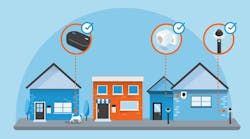Companies like Amazon are so entrenched in our day-to-day affairs that it’s hard to remember life before they arrived. Now, the retailing and cloud-computing behemoth wants to extend its wireless tentacles to envelop our homes more fully, and even our yards. Its vision for what it’s calling Amazon Sidewalk is a neighborhood network that will use Bluetooth LE and the 900-MHz spectrum to extend the low-bandwidth working range of our wireless devices. And it will help them stay connected even if they stray outside the range of our Wi-Fi routers—even up to 1 km away.
Access to Amazon Sidewalk, expected to launch later in 2020, will initially come through two types of devices: Sidewalk Bridges and Sidewalk-enabled devices. The former will include devices like Ring floodlight and spotlight cameras. The latter, things like smart lights in your driveway, will access the network through Sidewalk Bridges, especially useful if your driveway extends out of Wi-Fi range.
Amazon has already enlisted several IoT silicon vendors to produce the connecting links for Amazon Sidewalk:
- Nordic Semiconductor will engage on the Bluetooth LE side, with its low power-consumption nRF52 Series and newly released nRF53 Series SoCs providing connectivity. The company will also support the Amazon Common Software (ACS) platform with a device porting kit for its wireless chips, allowing them to be easily and natively integrated into ACS as one of its reference platforms.
- Semtech will contribute expertise on the 900-MHz LoRa front with its long-range, low-power IoT platform. It will extend the range of home networks to connect both outdoor and indoor, low-bandwidth smart-home products, including smart lights, pet trackers, sensors for asset tracking, smart irrigation, and a multitude of additional low-cost devices needed for residential use. Like Nordic, Semtech will offer development kits to help integrate its LoRa devices and the LoRaWAN protocol with Amazon’s IoT services.
- Silicon Labs pitches in with its EFR Wireless Gecko Series products to support Sidewalk's sub-gigahertz and Bluetooth LE protocols.
- Texas Instruments gets on the Sidewalk with numerous wireless MCUs, including (among others) its CC1352R (900 MHz and BLE) and CC1352P wireless MCUs; the latter incorporates a +20-dBm power amp for extended-range scenarios. TI also offers a Sidewalk-ready development kit to get applications up and running quickly.
Later this year, many Amazon Echo devices will support Amazon Sidewalk using Bluetooth LE, and those Echo devices will also be able to serve as Sidewalk Bridges. Another pending addition to Sidewalk is Tile devices, those little gizmos that keep you from losing your keys, wallet, or backpack. If you should drop one or the other on the Sidewalk, finding them will be a breeze. You could also hang one off Fido’s collar in the event he wanders away from home.
On top of that, Amazon Sidewalk is a community network—those with a Sidewalk Bridge can choose to contribute a small portion of their internet bandwidth to the larger network. Security is provided by three layers of encryption, one-way hashing keys, crypto algorithms, and more.
It’s an interesting endeavor, for sure, unless you have reservations about Amazon and its pervasiveness. Maybe you won’t mind as much when their drones start delivering your pizzas.

